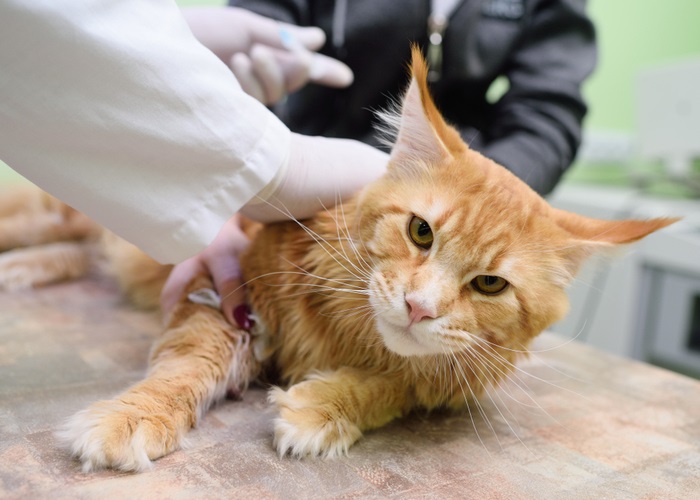alimentary lymphoma in cats
The most common anatomical form of lymphoma in cats is alimentary lymphoma AL. Symptoms of Feline Intestinal Lymphoma Alimentary Feline intestinal lymphoma is often referred to as an alimentary form of this cancer.

Lymphoma In Cats Veterinary Partner Vin
Lymphoma in cats is now most commonly seen in the intestines.

. If a cat is leukemia free there is a chance the cat will. Get NHVs Lymphoma Gold Support Pack Today. Differentiation of feline inflammatory bowel disease and intestinal small cell lymphoma can be challenging and some clinicians argue that it is unnecessary because prognosis and treatment are similar.
The incidence of LGAL has increased over the last ten years and it is now the most frequent digestive neoplasia in cats and comprises 60 to 75 of gastrointestinal lymphoma cases. Experts believe there is no link between this form and feline leukemia. In the authors hospital in Tokyo Japan in the recent years among 43 cases of microscopically confirmed feline lymphoma cases 51 were the alimentary form while FeLV positive anterior mediastinal form accounted for 16.
The blood tests are often normal but ultrasound of the abdomen may show thickened intestines enlarged abdominal lymph nodes and tumors. Alimentary lymphoma was the most common anatomical location followed by the abdominal combination classification and renal lymphoma. Low-grade alimentary lymphoma LGAL is characterised by the infiltration of neoplastic T-lymphocytes typically in the small intestine.
Physical exam findings may be normal though thickened intestines or abdominal masses may be felt. J Feline Med Surg. Clinical signs of lymphoma in the gastrointestinal tract include weight loss vomiting diarrhea and often either a decreased or increased appetite.
The median or average age of the cats with alimentary lymphomas is around 10 years old and they are mostly FeLV negative. In the authors hospital in Tokyo Japan in the recent years among 43 cases of microscopically confirmed feline lymphoma cases 51 were the alimentary form while FeLV positive anterior mediastinal form accounted for 16. The most common subtype is known as enteropathy-associated T cell lymphoma EATL type II or small cell lymphoma and accounts for 10-20 of all tumors with approximately 200 cases per 100000 cats reported each year.
The median or average age of the cats with alimentary lymphomas is around 10 years old and they are mostly FeLV negative. Accurate diagnosis is important to guide appropriate treatment. The current study identified a greater risk of feline lymphoma with older aged insured unvaccinated and male cats in the multivariable analysis.
In 1 study 36 cats with alimentary lymphoma treated with either vincristine cyclophosphamide and prednisone or with chlorambucil and prednisone had a survival time of 2 to 2120 days median. Ad Help keep your pet comfortable in their fight against lymphoma. Differentiating Inflammatory Bowel Disease from Alimentary Lymphoma in Cats.
Lymphoma is the most common feline malignant tumor and the alimentary form is the most common seen form. Differentiation of low-grade alimentary lymphoma from lymphoplasmacytic enteritis can be challenging especially. Despite the common prevalence of this disease appropriate diagnosis and treatment can be challenging.
Alimentary form in the cat typically involves lesions of the small intestine stomach. Ad 35 Off Your First Autoship Easy Refills. Vet Clin North Am Small Anim Pract.
Alimentary lymphoma is one of the most commonly diagnosed neoplasms of the cat. 12 hours agoHowever they are categorized into 4 types of lymphoma in dogs. It is characterized by an infiltration of the gastrointestinal tract andor associated lymph nodes with neoplastic cancerous lymphocytes.
Fast Free Delivery wAmazon Prime. We Offer the Same Medications As Your Vet at Great Prices. Intestinal lymphomas usually cause poor eating weight loss diarrhea and vomiting.
Multicentric or Systematic Lymphoma begins on lymph nodes in multiple places Alimentary or Gastrointestinal Lymphoma found on. Bloodwork is likely to be normal in cats with gastrointestinal. Alimentary lymphoma AL occurs commonly in cats and exists as distinct subtypes that differ in their clinical course response to treatment and prognosis.
Ad Read Customer Reviews Find Best Sellers. There are three subtypes based on mitotic rate and cell type determined by examination. Alimentary affects the digestive system and lymph nodes around that area.
Feline alimentary gastrointestinal lymphoma is the most common cancer diagnosed in domestic cats. Feline low-grade alimentary lymphoma. Although EATL type I or.
The incidence of this disease has increased significantly over the past 15 years during the post-feline leukemia era.

Lymphoma In The Cat Fact Sheet Davies Veterinary Specialists

Lymphoma In Your Cat Ron Hines Vetspace 2nd Chance The Animal Health Website

3 Ways To Treat Feline Intestinal Lymphoma Wikihow

Feline Lymphoma In The Spinal Cord A Lymphoma In The Cervical Download Scientific Diagram

Feline Low Grade Alimentary Lymphoma An Emerging Entity And A Potential Animal Model For Human Disease Springerlink

Focus On Feline Gastroenterology Today S Veterinary Practice

Lymphoma In Your Cat Ron Hines Vetspace 2nd Chance The Animal Health Website

How To Diagnose Feline Intestinal Lymphoma 9 Steps

Causes And Risks Of Cat Lymphoma And Leukemia Vlog 97 Youtube

How To Diagnose Feline Intestinal Lymphoma 9 Steps

Alimentary Lymphoma In A Cat Semantic Scholar

Lymphoma In Cats Veterinary Partner Vin

Feline Low Grade Alimentary Lymphoma An Emerging Entity And A Potential Animal Model For Human Disease Springerlink

Extranodal Lymphoma In The Cat Semantic Scholar

Lymphoma In Cats Symptoms Diagnosis Treatment All About Cats

